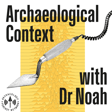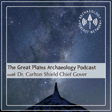
The Iceman Ötzi P1 - A prehistoric murder case – With Dr Albert Zink (S01E07)
The Iceman, this may sound like the name of a wrestler or comic-book hero, but today we’re actually talking about one of the most sensational archaeological discoveries of the 20th century. Exactly 30 years ago in 1991 this now world-famous mummy was discovered accidentally, in the Ötztal Alps between Austria and Italy, at an altitude of 3210 meters. At the time of discovery, it was unclear what a sensational find the frozen body represented. But after the effective age of the mummy of over 5000 years was proven, media interest was enormous. The German speaking media gave the individual the name Ötzi (from the Ötztal mountain range). In the English-speaking world, he was named "The ice man", or "Man from the ice".
In these 30 years since his discovery, Ötzi's body have been studied by many different sciences, from archaeology, anthropology medicine, forensics, botany and so on. And I am very happy to present to you my conversation with Dr. Albert Zink, head of the institute for mummy studies at the European academy in Bolzano and actually in charge of preserving the body of the prehistoric Iceman.
Reverences:
- Maixner et al. (2018), The Iceman's Last Meal Consisted of Fat, Wild Meat, and Cereals
- Fleckinger Ed. (2011), Ötzi 2.0: Eine Mumie zwischen Wissenschaft, Kult und Mythos
- Möckli (2011), Medizinische Untersuchungen und Ergebnisse an Ötzi
Website: https://23minarch.com
Support: patreon.com/23minarch





